Rifle battle cruisers. "Hood" and "Ersatz York". H. 3
The reason for the detonation of the ammunition was identified fairly quickly, it was the special properties of the gunpowder used by the English - cordite, prone to instantaneous explosion when ignited. However, as experts rightly noted, it all begins with the penetration of armor - if the German shells did not easily penetrate the turrets, barbety and other defenses of the English battlecruisers, there would be no fires.
Nevertheless, the first offer of the sailors - the reinforcement of the armor deck in the area of the ammunition cellars - provoked the protest of the shipbuilders. Those argued that with the second and third armor belts protecting the side to the upper deck, the defeat of the ammunition cellar is almost impossible even with the available horizontal protection thicknesses - they say, the projectile, punching the side belt, loses much speed, partially deformed, plus changes the angle of incidence (when the vertical armor penetrates, the projectile turns to its normal, that is, it deviates from its original trajectory to the plane located under 90 degrees to the armor pierced by it), and all this videtelstvuet that such a projectile into the deck armor will not get any at all, or else fall, but at a very small angle and ricocheted away. Therefore, the head of the Shipbuilding Office, Tennyson d'Eincourt, proposed a very moderate adjustment to the protection of the newest battlecruisers.
In his opinion, first of all it was necessary to increase the height of the main armor belt, in order to improve the ship’s protection under water - d'Einkort was worried about the possibility of hitting the projectile “under the skirt”, that is, unarmored board under the lower section of the armor plates. So he proposed to increase the 203 mm belt by 50 cm, and in order to somehow compensate for the increase in mass, reduce the thickness of the second armor belt from 127 to 76 mm. However, such a scheme obviously contradicted the previously expressed arguments concerning the inaccessibility of artillery grabs for projectiles falling into the armor-protected side - it was obvious that the combination of 76 mm vertical and 38 mm horizontal protection could not stop a heavy shell. Therefore, d'Einkort increased the thickness of the forecastle deck and the upper deck (obviously, only above the artillery graves) to 51 mm. In addition, it was proposed to significantly strengthen the booking of towers - the front plates should have become 381 mm, the side panels - 280 mm, the roof - 127 mm. There were some other small details about the reinforcement - it was proposed to cover the 25 mm with sheets to cover the transshipment compartments for 140-mm guns, the armor protection of the flues should increase to 51 mm.
Perhaps the only advantage of this version of the “reinforcement” of body armor was a relatively small overload relative to the original project: it had to make up the entire 1 200 t, that is, the entire 3,3% of the normal displacement. At the same time, an increase in precipitation on 23 cm was expected, and the speed should have been 31,75 nodes, that is, the degradation was minimal. However, without a doubt, such “innovations” did not give a cardinal increase in the security that the future “Hood” needed and therefore this option was not accepted by the sailors. However, he didn’t suit the shipbuilders either - it seemed that d'Eincourt just took a little time to get used to the new realities. His next proposal literally struck the imagination - it was, in fact, about a 1.5-fold increase in armor thickness - instead of 203 mm of armor belts 305 mm was proposed, instead of 127 mm second and 76 mm of the third belt - 152 mm, and the thickness of barbet should be increased from 178 mm to 305 mm. This increased protection resulted in an increase in the ship’s mass on the 5 000 T or 13,78% of the normal displacement according to the original design, but, oddly enough, calculations showed that the battlecruiser’s hull was able to withstand such abuse without problems. The draft was supposed to increase by 61 cm, the speed was to decrease from 32 to 31 nodes, but, of course, this was an acceptable reduction in performance for such a large-scale reinforcement armor. In this form, the battle cruiser became quite comparable to the queen Elizabeth type battleship in terms of protection, while its speed on 6-6,5 knots was higher, and the draft was less on 61.
This option, after some improvements, and became final - it was approved by 30 September 1916, however, and after that the discussion about changing certain characteristics of the cruiser continued. D. Jellicoe succeeded in this especially, who constantly demanded next changes - some of them were accepted, but in the end the Shipbuilding Board had to fight back from his demands. At some point, d'Eincourt even suggested stopping construction and dismantling the Hood right on the slipway, and instead designing a new ship that would fully take into account both the experience of the Jutland battle and the sailors' wishes, but then there was a significant delay in construction, and The first battlecruiser could have entered service no earlier than 1920 d - that the war would last for so long, no one could allow (and in fact this did not happen). The proposal of the Shipbuilding Department was rejected, but the final draft of the ship under construction (with all changes) was approved only by 30 in August 1917.
Artillery
The main caliber of the Hood was represented by eight 381-mm guns in four towers. We have already indicated their characteristics several times, and we will not repeat it — we only note that the maximum elevation angle that the Huda towers could provide, already during construction, was 30 degrees. Accordingly, the firing range of 871 kg of shells amounted to 147 cables - more than enough for the then existing fire control systems. However, in the early 30s, the Royal fleet new 381-mm shells with an elongated warhead arrived, which provided a firing range of 163 kbt.
However, the tower installations at Hud also had their own nuances: the fact is that the towers of the previous project could be charged at any angle of elevation, including the maximum 20 for them. The loading mechanisms of the Hud towers remained the same, thus, when shooting at elevation angles above 20 degrees. the guns of the battle cruiser could not be charged - they needed to be lowered to at least 20 degrees, which lowered the rate of fire when firing at long distances.
However, such a decision can hardly be considered a major drawback in the design of the towers: the fact is that the loading on the corners of 20-30 hail required more powerful, and therefore heavier mechanisms, which unnecessarily made the structure heavier. The British 381 towers turned out to be extremely successful, but such a refinement of the mechanisms could reduce their technical reliability. At the same time, tower mechanisms provided a vertical guidance rate of up to 5 degrees / sec, so the loss of firing rate was not very significant. The undoubted advantage was the replacement of tower rangefinders with "15-feet" (4,57 m) for much more accurate and perfect "30-feet" (9,15 m).
Peacetime ammunition made 100 shells per barrel, while the bow turrets were supposed to get more 12 shrapnel on each of the guns (aft towers did not rely on shrapnel). Wartime ammunition was supposed to make 120 shells on the barrel.
Interestingly, the main caliber of "Hud" could differ significantly from the original four two-gun towers. The fact is that already after the reservation was drastically strengthened in the project, the admirals suddenly wondered whether it was worth stopping at what had been achieved and whether to increase the fire power of the future ship as dramatically? A choice of nine 381-mm guns in three three-gun turrets, ten of the same cannons in two three-gun and two two-gun turrets, or twelve 381-mm in four three-gun turrets were offered. The most interesting thing is that everything could have happened if it were not for the British’s desperate reluctance to adopt three-gun turrets. Despite the fact that many countries (including Russia) quite successfully exploited such towers, the British still feared that they would have low technical reliability. Interestingly, literally in a few years, the very same British in the promising projects of battleships and battlecruisers already used exclusively three-gun towers. But alas, at the time of the creation of Hud, such a decision was still too innovative for them.
It must be said that the “Hood”, surprisingly enough, was quite capable of carrying ten and twelve such guns. In the version with 12 * 381-mm, its normal displacement (taking into account the booking gain) exceeded the design one by 6 800 t and was 43 100 t., While the speed should have remained somewhere between 30,5 and 30,75 knots. In general, the ship, no doubt, significantly lost in all the qualities that until Jutland seemed important to British sailors, such as high board, low draft and high speed, but they still remained at an acceptable level. But the output was a real supermonstra, a thunderstorm of the oceans, protected on the level of a good battleship, but much faster and one and a half times more powerful than any other ship in the world. Most likely, the possibilities of modernization in this case would not be particularly great, but ... as you know, in reality, the “Hood” never received a thorough modernization.
As for the technical reliability of the towers, the Khudu would still not have been able to make war during the First World War, and between the wars the British would have enough time to correct any shortcomings - but one would expect that such an experience would give much in this case, the British designer of the Nelson and Rodney towers could have been better than in reality.
The anti-mine caliber of the battle cruiser was represented by 140-mm "Greek" cannons, which, according to the initial design, were to install 16 units, but during construction were reduced to 12 units. For a long time, the British themselves were completely satisfied with the capabilities of the 152-mm artillery, and the 140-mm artillery systems were designed by request of the Greek fleet, but with the start of the war these guns were requisitioned and thoroughly tested. As a result, the British came to the conclusion that, despite the much lighter projectile (37,2 kg versus 45,3 kg), 140-mm artillery outperformed six-inch guns - not least because the calculations were able to maintain a high rate of fire much longer. The British liked the 140-mm cannon so much that they wanted to make it uniform for the armament of the battleships and the main caliber of light cruisers - this was not possible for financial reasons, so only Furyes and Hood were equipped with weapons of this type.
The 140-mm unit had a maximum elevation angle of 30 degrees, the firing range was at the same time 87 cables with an initial speed of 37,2 kg 850 projectile m / s. The ammunition consisted of 150 shells in peacetime and 200 - in wartime and was completed with three-quarters high-explosive, and one - with armor-piercing shells. Interestingly, when designing the supply of these shells, the British tried to learn from the tragedy of the battleship “Malaya”, where the explosion of ammunition in the casemates of 152-mm guns led to a massive loss of calculations and the failure of almost the entire anti-mine caliber of the ship. This happened due to the accumulation of projectiles and charges in dungeons, so that this would not happen in the future, on the "Hude" acted as follows. Initially, the shells and charges from the artillery cellars fell into special corridors that are under the armor deck and under the protection of the onboard armor. And there, in these protected corridors, ammunition was fed to individual elevators, each of which was intended to serve one gun. Thus, the probability of the explosion of ammunition, according to the British, was reduced to a minimum.
Interestingly, the British considered the possibility of placing 140-mm artillery in the towers, and this decision was considered very tempting. But due to the fact that the towers greatly increased the "upper weight" of the battle cruiser, and most importantly, they had to be developed from scratch and this would have greatly delayed the launch of the Hud into operation, it was decided to abandon them.
Anti-aircraft artillery was represented by four 102-mm cannons, which had an angle of elevation to 80 hail, and fired 14,06 kg shells with an initial speed of 728 m / s. The rate of fire was 8-13 shots / min., Reach height - 8 700 m. For its time, these were quite decent anti-aircraft guns.
Torpedo armament
As we said earlier, the initial project (with the 203-mm armor belt) assumed the presence of only two torpedo tubes. However, the Shipbuilding Department was in doubt about their usefulness, so that in March 1916 r the designers turned to the Admiralty with the appropriate question. The sailors' response was: “Torpedoes are very powerful weaponwhich can be a major factor in the war at sea and even decide the fate of a nation. " It is not surprising that after such a statement, the number of torpedo tubes in the final Hud project reached ten or eight surface and two underwater vehicles! Then, however, they refused from the four surface torpedo tubes, but the six remaining ones (more precisely, two single-tube and two two-tube ones) can hardly be called a victory of common sense.
They were equipped with ammunition from twelve 533-mm torpedoes - having a weight of 1 522 kg, they carried 234 kg BB and had a range 4 000 m at speed 40 knots or 12 500 m at speed 25 knots.
Reservation
The basis of the vertical protection was 305-mm armor belt 171,4 m length and about 3 m height (unfortunately, the exact value of the author of this article is unknown). Interestingly, he relied on the over-thick sideboarding that made up the 51 mm of ordinary shipbuilding steel, and besides, it had a slope of about 12 degrees - all this, of course, provided additional protection. Under normal displacement, 305-mm armor plates were on 1,2 m under water, in full load - on 2,2 m, respectively, depending on the load, the height of the 305-mm armor section ranged from 0,8 to 1,8 m. Due to the large length, the belt protected not only machine and the boiler rooms, but also the feed pipes of the main-caliber towers, although part of the barbet of the bow and stern of the towers were a little in favor of 305-mm armor. To them from the edges of 305-mm armor plates went 102-mm traverse. Of course, their small thickness attracts attention, but it must be borne in mind that the vertical booking was not limited to the citadel - 7,9 mm on the 15,5 mm and 305 mm armor plates on the 152 mm lining, and 38 mm on the 152 mm The armored nose was a few more meters protected by 127 mm plates. This vertical protection of the fore and aft end was closed with 127 mm by cross-beams.
It is also interesting that the British found the penetration of 305 mm of armored plates under water to be insufficient to withstand projectiles that fell into the water near the side, but with enough energy to hit the underwater part of the hull. Therefore, below the 305 mm belt, there was another 76 mm belt with a height of 0,92 mm, supported on the 38 mm panel.
Above the main armored belt, the second (178 mm thick) and the third (127 mm) were located on the 25 mm substrate and had the same angle of inclination 12 deg.
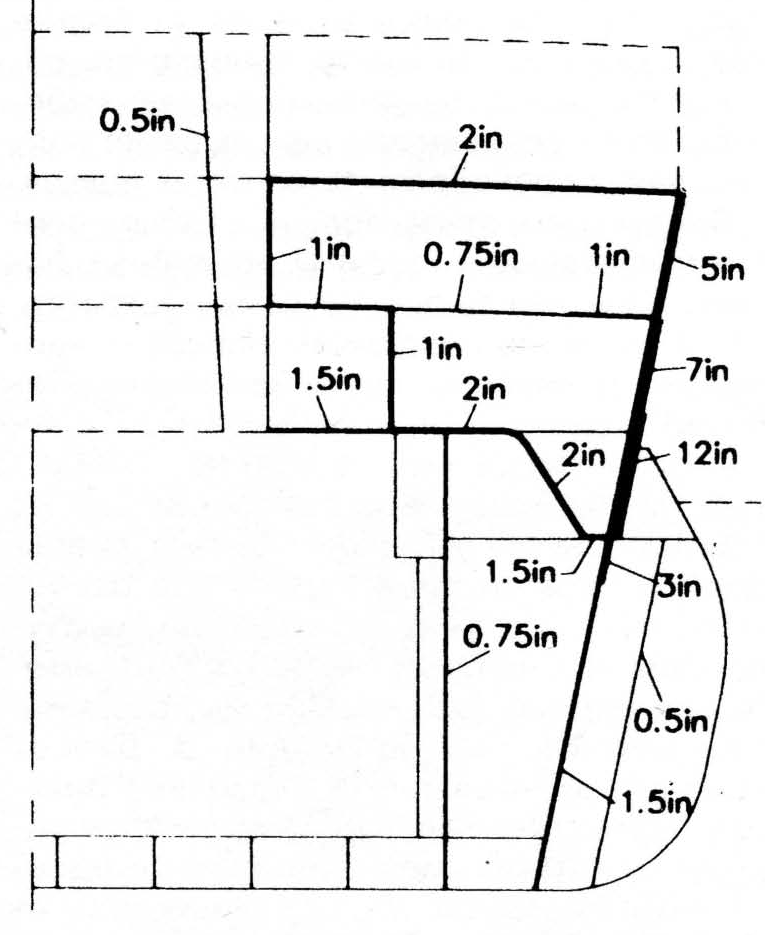
The length of the second belt was slightly lower than the main one, its edges just “reached out” to the barbets of the first and fourth towers of the main caliber. From its edges approximately to the middle of the aft tower barbet, 127 mm traverse went. But there was no such traverse in the nose - 178 mm armor was completed in the same place as 305 mm, but further from him was 127 mm armor, and here it was in turn ended with the traverse of the same thickness. Above there was a significantly shorter third armor belt with a thickness of 127 mm, which defended the board right up to the deck of the forecastle deck, respectively, where the forecastle ended, and the armor ended there. In the stern, this armor belt was not closed by traverse, but in the nose its edge was connected to the middle of the barbet of the second tower of 102 mm armor. The height of the second and third belts was the same and was 2,75 m.
The horizontal case protection was also very ... let's say, diversified. Its basis was the armor deck, and three of its sections should be distinguished; within the citadel, outside the citadel in the vicinity of the armored side and outside the citadel in the unarmored extremities.
Within the citadel, its horizontal part was located just below the upper edge of the 305 mm armor belt. The thickness of the horizontal part was variable - 76 mm above the ammunition cellars, 51 mm above the engine and boiler rooms and 38 mm in other areas. From it to the bottom edge of the 305 mm belt, there were 51 mm bevels - it is interesting that if, on warships, the lower edge of the bevel was connected to the lower edge of the armor belt, then at Hud they were connected with each other by a small horizontal “jumper” that also had 51 mm thickness . Outside the citadel in the area of the armored side, the armored deck had no bevels and ran along the upper edge of the 152 and 127 mm belt in the bow (here its thickness was 25 mm) and also over the 152 mm belt in the stern, where it was twice as thick - 51 mm. In the unarmored ends of the armor deck located below the waterline, at the level of the lower deck and had a thickness of 51 mm in the bow, and 76 mm in the aft, above the steering mechanisms. From the description of the reservation given by Kofman, it can be assumed that the lower deck had armor protection in the cellars of the main caliber towers 51 mm thick (in addition to the armor deck described above, but lower than it), but the extent of this protection is unclear. Presumably, the cellar defense here looked like this - within the citadel, above the artillery houses, the 76 mm armor deck was located, but it did not cover part of the cellars of the first and fourth towers of the main caliber, thinning to 25 mm and 51 mm, respectively. However, under this deck was still armored bottom, whose thickness in these "weakened" areas reached 51 mm, which gave the total thickness of the horizontal protection 76 mm in the bow and 102 mm in the stern.
This “injustice” was leveled by the main deck, located above the armor above the upper edge of the 178 mm armor belt, and everything was much simpler here — it had a thickness of 19-25 mm in all places except the nose towers — there it thickened to 51 mm — thus, taking into account the main deck, the cumulative horizontal protection leveled to 127 mm in the areas of artillery grabs of the main caliber towers.
Atop the deck of the main deck (on top of 76 mm of armored belt) was the forecastle deck, which also had a variable thickness: 32-38 mm in the bow, 51 mm above the engine and boiler rooms and 19 mm further into the stern. Thus, the total thickness of the decks (including armor and structural steel) was 165 mm above the armored nasal towers, 121-127 mm above the boiler rooms and engine rooms and 127 mm in the area of the main caliber stern towers.
The main caliber towers, which had the shape of a polyhedron, were very well protected — the frontal plate was 381 mm thick, the side walls adjacent to it were 305 mm, then the side walls were thinned to 280 mm. Unlike the 381-mm turrets on the ships of the previous types, the roof of the Hud towers was almost horizontal - its thickness was 127 mm of homogeneous armor. The barbets of the towers above the deck had quite a decent protection 305 mm thick, but below it varied depending on the thickness of the side armor protection behind which barbet passed. In general, the British sought to have 152 mm barbet for side armor 127 mm and 127 mm barbet for armor 178 mm.
The Hood received a significantly larger conning tower than the ships of the previous types had, but it had to be paid for by some weakening of its armor - the felling head made 254 mm armor plates, the sides 280 mm, but the rear protection consisted only of 229 mm plates. The roof had the same horizontal armor 127 mm as the turret. In addition to the conning tower itself, the shooting control post, the control tower, a specially designated and admiral’s combat room separately separated from the conning tower (above it), were protected by armor plates from 76 to 254 mm. Below the conning room, rooms under it all the way to the deck of the forecastle had an 152 mm reservation. The aft control box for torpedo shooting had 152 mm walls, 102 mm roof and 37 mm base.
In addition to armor, the “Hood” received, perhaps, the most perfect underwater protection among all the ships of the Royal Navy of military times. It was based on boules that had a length of 171,4 m, that is, the same as 305 mm armor. Their outer skin was 16 mm thick. They were followed by an 12,7 mm beadboard (or bulkhead inside the boules) and another compartment filled with metal pipes of length 4,5 m and diameter 30 cm, while the ends of the tubes were sealed on both sides. The compartment with tubes was separated from the other rooms of the ship 38 mm bulkhead. The idea was such that the torpedo landed in boules would waste some of its energy on breaking through its skin, after which the gases, hitting a fairly large empty space, would expand and this would significantly reduce the effect on the side sheathing. If it is also pierced, the pipes will accept the explosion energy (they will absorb it, distorting it) and in any case, even if the compartment is flooded, they will provide a certain amount of buoyancy.
Interestingly, in some of the drawings, the compartment with the tubes is located inside the body, while in others - inside the bulls themselves, the author of this article does not know what is right about this. It can be assumed that in the widest parts of the body the “tubular” compartment was in it, but closer to the extremities it “moved” to the boules. In general, as you can understand, the width of such anti-torpedo protection ranged from 3 to 4,3 meters. At the same time, for the said PTZ there were compartments with oil, which, of course, also played a certain role in protecting the ship from underwater explosions. In the areas of the nose towers of the main caliber, these compartments were wider, in the area of machine and boiler rooms - already, but along the entire length of them from the rest of the body separated 19 mm bulkhead. In order to somehow compensate for the smaller width of the fuel compartments along the turbines, the bulkheads inside the boules were thickened from 12,7 to 19 mm., And in the area of the main caliber aft towers, where PTZ was the least deep - even to 44 mm.
In general, such protection can hardly be called somehow optimal. The same metal pipes obviously overloaded the hull, but hardly provided a gain of protection adequate to the mass expended on them, and the increase in buoyancy that they could provide was absolutely meager. The depth of the PTZ is also difficult to find sufficient, but this, by the standards of the interwar period and the Second World War, was a great step forward for the ship of the military construction of the PTZ Hud.
Power plant
As we said earlier, the rated power of the Hud machines was 144 000 hp, the ship was expected to develop 31 knots despite this overload. The steam was given an 24 boiler of the Yarrow type, with hot-water tubes of small diameter - this solution gave an advantage of about 30% power compared to “wide tube” boilers of the same mass. The specific weight of the Huda steam turbine unit was 36,8 kg per hp, while for Rinaun, which received the traditional chassis, this indicator was 51,6 kg.
On testing mechanisms "Hud" have developed the power of 151 280 HP that the displacement of the ship 42 200 t allowed him to reach 32,1 bonds. Surprisingly, but a fact - with a displacement very close to the full (44 600 t), with a power 150 220 hp the ship has developed a 31,9 node! It was an excellent result in every respect.
Of course, the thin-tube boilers were quite new for the British on large ships - but the experience of their operation on destroyers and light cruisers led to the fact that there were no serious problems with their operation on the Hude. On the contrary, in fact they were even easier to maintain than the old wide-tube boilers of other British military-built battleships. In addition, the Hud power plant demonstrated excellent longevity — despite the fact that during its 20 years of service, the boilers never changed and its power plant did not undergo major modernization, despite the fouling of the hull, the Hood was to develop 1941 nodes. We can only express regret that the British did not dare to immediately switch to thin-tube boilers - in this case (if you wish, of course!), The protection of their battle cruisers with 28,8-mm guns could be significantly enhanced.
The normal supply of oil was 1 200 T, full 3 895 T. The range on 14 nodes was 7 500 miles, with 10 nodes 8 000 miles. Interestingly, on the 18 nodes, the battlecruiser could go 5 000 miles, that is, he was not only a "sprinter" capable of overtaking any battleship or battle cruiser of the world in battle, but also a "stayer" capable of quickly moving from one ocean region in another.
The seaworthiness of the ship ... alas, does not allow him to give an unequivocal assessment. On the one hand, it cannot be said that the ship was excessively subject to rolling, from this point of view, in the opinion of the British sailors, it was a very stable artillery platform. But the same British sailors gave the Hood a nickname “the biggest submarine” deservedly so. It was more or less good with the forecastle on the deck, but still it “flew in” due to the fact that the huge ship tried to cut the wave through its hull rather than climb it.
But the feed was poured constantly, even with weak excitement.
The huge length of the ship led to its poor turning, and the same could be said about acceleration and braking - both “Hood” did very reluctantly. Not the biggest problem in the artillery battle, but this battlecruiser was not intended to avoid the torpedoes from the torpedoes - fortunately, during the years of its service, he did not have to do that.
In the next article, we will compare the capabilities of the last British line cruisers built in the UK with the German Ersatz York.
Продолжение следует ...
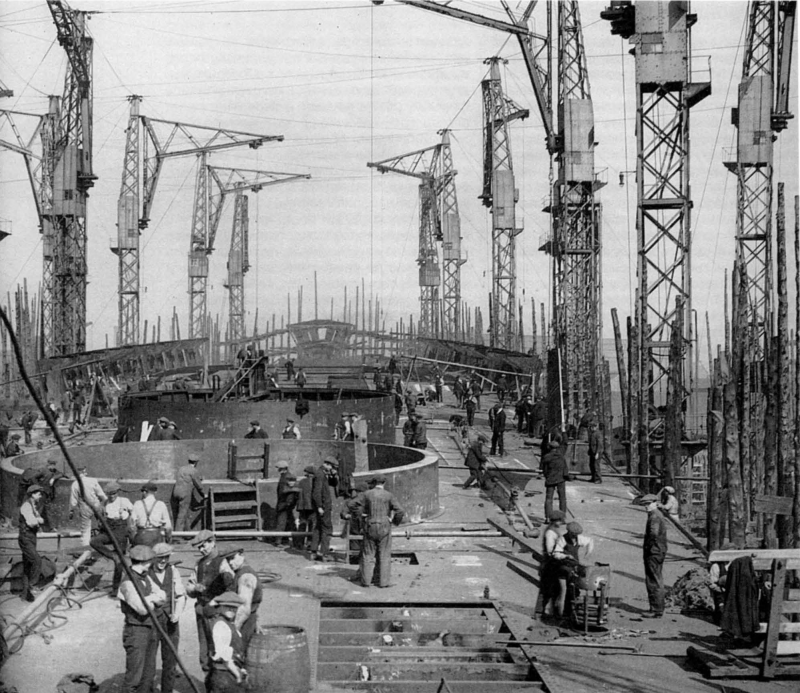
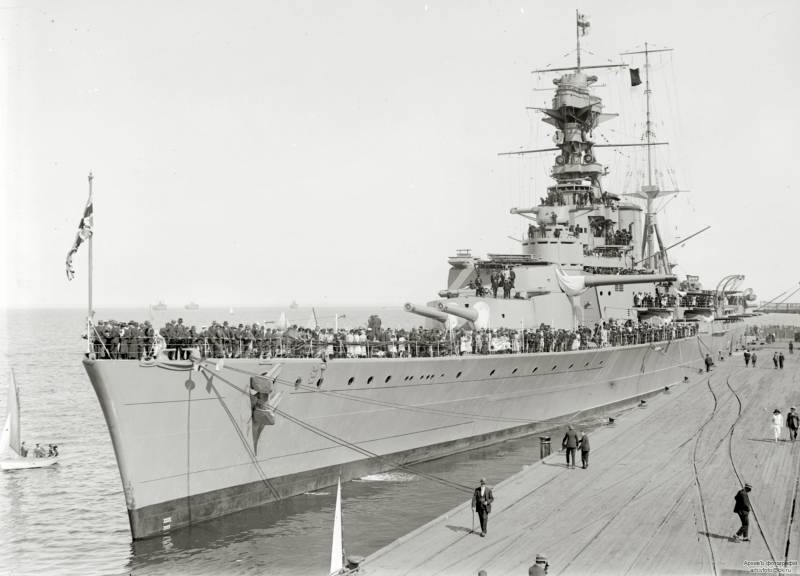
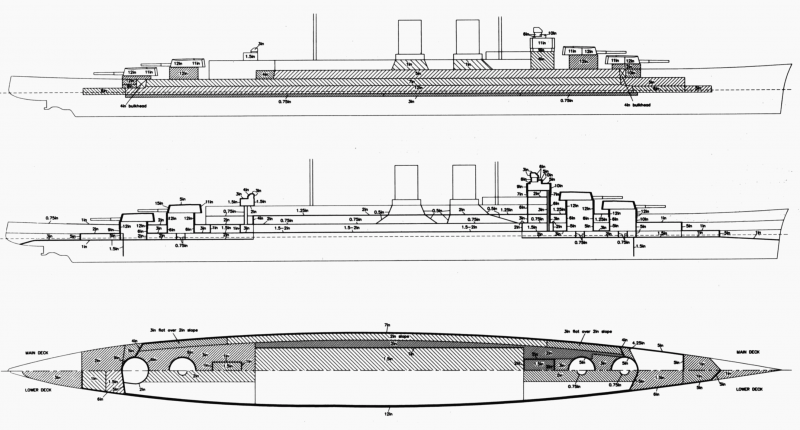
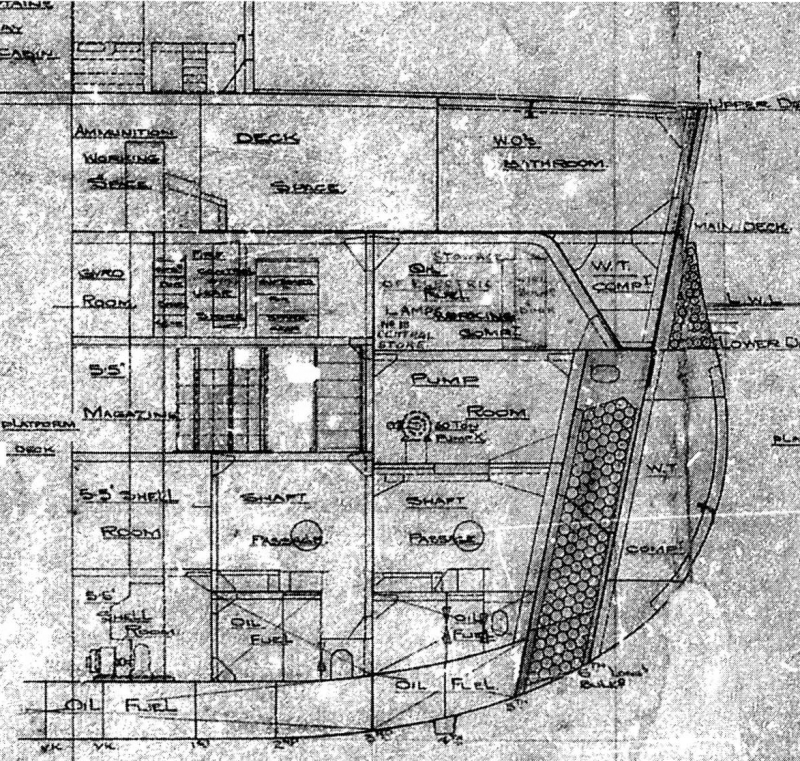
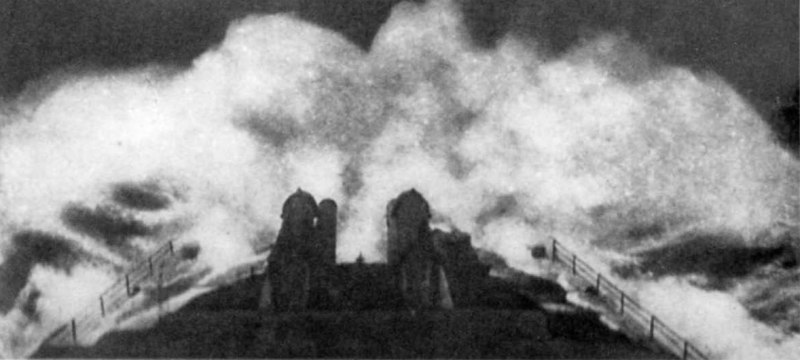
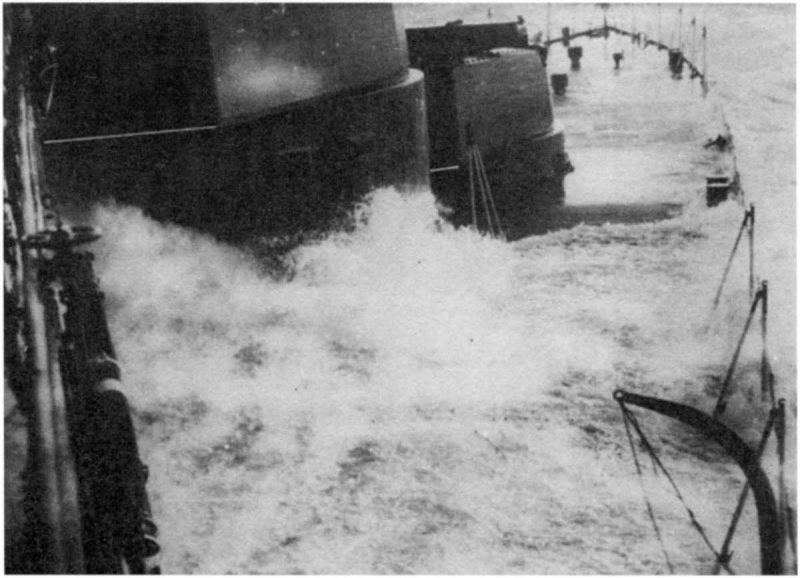
Information